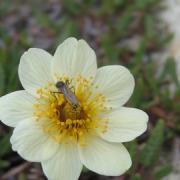Climate changes to blame for fewer insects in the Arctic
Climate changes to blame for fewer insects in the Arctic

Climate changes in the last couple of decades have made conditions more difficult for Arctic insects. Many species of flora and fauna depend on each other’s presence at the same time and the same place in nature. Flowers and pollinators such as bees must ‘peak’ simultaneously to create a fruitful collaboration, implying that the flowers set seeds and the bees can feed on pollen and nectar. The climate changes may disturb this balance and thus create a ‘mismatch’ between the species. For instance, if the overlap between the flowering period and the flight season of the insects becomes shorter, there is less food available to the insects and fewer will survive to maintain the population the year after.
Overall shorter flowering period
During the period 1996 to 2009 eighteen biologists from Aarhus University have investigated flowering and the number of pollinators at the Zackenberg Research Station in Greenland. Their investigations demonstrate that the overall flowering period of a number of different plant species has become shorter during the investigation period. At the same time the number of pollinators is declining, with notable decreases in the years following a year with a particular pronounced ‘mismatch’ in the overlap between flowers and insects. The results have just been published in the esteemed scientific journal Nature Climate Change.
‘Our investigations demonstrate that particularly plant species with late flowering show marked shifts and flower much earlier than before. This implies that the total flowering period across species has decreased. In the same period a dramatic temperature increase of 2.5 oC has been measured at Zackenberg. It is thus reasonable to conclude that the climatic changes are responsible for the changes in flowering and thereby the resulting ‘mismatch’ between flowers and insects,’ says project manager senior scientist Toke Thomas Høye from the Department of Bioscience, Aarhus University.
Flowers provide shelter for insects
Besides the facts that various plant species have shifted their flowering time and that the total flowering period has become shorter, the researchers also observe a tendency to more synchronous flowering of the same species, whereas – before - some ‘patches’ or populations flowered early and some flowered later. This again implies a shorter ‘window' for pollinators to gather pollen and nectar. An example of this is dryas where differences in flowering between local populations earlier could be as much as one and a half months, but now is only twenty days in extreme years.
The flowers have another important function besides providing food for insects:
’The cold Arctic climate constitutes a particular challenge to the insects. A flower in full bloom functions as a small ‘satellite’ that retains heat for the insects and acts as a shelter. If flowering has ceased when the insects arrive, they will be even more vulnerable due the combination of absence of food and lack of heat and shelter,’ explains Toke Thomas Høye.
Climate changes may have dramatic consequences for biodiversity
Which are the long-term effects of fewer insects in the Arctic? It is not difficult to foresee that fewer insects may lead to fewer seeds, which may also impact many birds preying on insects.
‘So-called ‘trophic cascades’ – i.e. that one effect in nature triggers cascade effects on other parts of nature – are always difficult to pinpoint due to the complexity of the interactions. Therefore, we can only provide guesses about the long-term effects of the tendencies traced in our investigations. However, the better we understand the individual elements, the more we can say about the consequences, implying that more investigations of biodiversity in Arctic areas are needed, for instance on insect species richness, which is poorly documented today,’ says Toke Thomas Høye.
For more information, please contact
Senior scientist Toke Thomas Høye
Department of Bioscience
Aarhus University
+45 3018 3122
toh@dmu.dk





